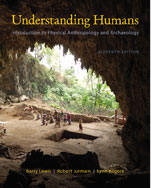- Now an Advantage book, this edition builds on the prior edition and is even more streamlined with 16 Chapters that now includes one succinct chapter on "The Rise of Civilizations" (Chapter 15) and a new "Conclusion" (Chapter 16).
- Fossils are presented in chronological order for easier student comprehension of the interpretation of human evolution. More examples throughout the text help students better understand the work of practicing physical anthropologists and archaeologists, including more material on the contributions of archaeology to the understanding of human evolution and adaptation.
- "Digging Deeper" boxes and "Cutting Edge Research" essays have now been moved to the companion website for more functionality, with key material being retained and integrated into the text.
- The book provides balanced coverage of physical anthropology and archaeology, including methods; human evolution; living nonhuman primates; human adaptation and variation; the origin and dispersal of modern humans; food production; and the first civilizations of the Old and New Worlds.
- The strong pedagogical program has been enhanced in this edition with re-drawn maps and line drawings, and superior new photographs while the "At A Glance" quick reviews, "Most Significant Fossils (or sites) Found in This Chapter," and the running glossary continue to help students better understand and focus on the key concepts.
UNDERSTANDING HUMANS: INTRODUCTION TO PHYSICAL ANTHROPOLOGY AND ARCHAEOLOGY shows students how anthropologists and archaeologists go about their work as they study human evolution, living nonhuman primates, human adaptation and variation, the origin and dispersal of modern humans, food production, the first civilizations of the Old and New Worlds, and so much more. Using a biocultural approach, the text balances the presentation of physical anthropology with archaeology and concludes with a new chapter that ties together the material on human biological and cultural adaptation by focusing on lessons learned from our species evolution such as the impact of humans on the environment. Students will also benefit from the new chapter opening learning objectives, "At a Glance" sections that summarize key concepts, and end-of-chapter "Critical Thinking Questions" that help students better understand the material and study more effectively for exams.
Features





